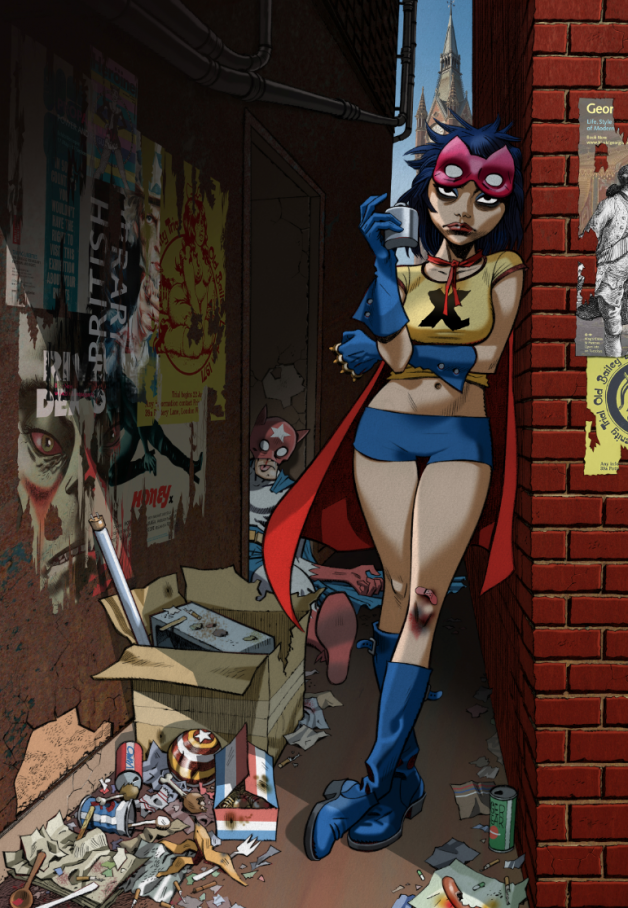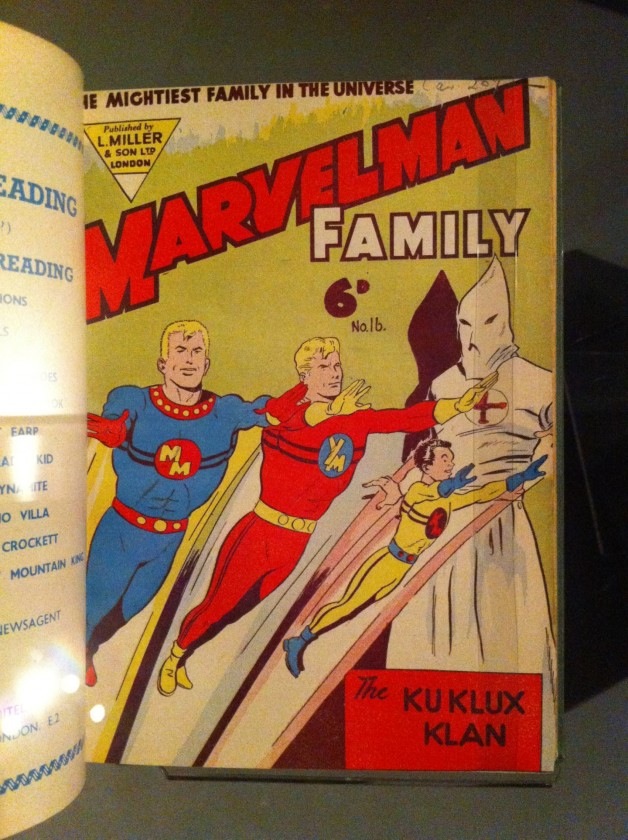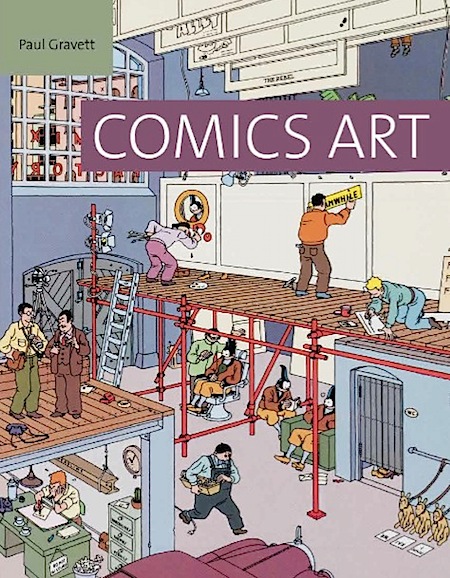
If there was ever a reason to go to England, as if more than real mushy peas was needed, this summer’s “Comic Unmasked: Art and Anarchy in the UK” exhibition at the British Library is the one. Not only is it the biggest exhibit of British comics yet, it is by far the most official, and will be, I daresay, the most influential. Curated by Paul Gravett, along with John Harris Dunning, this is no mere “Oh look comics are cool!” exhibit, but a bracing investigation of the often transgressive gutter nature of comics in a specific culture. Since there is little chance I’ll be able to go see it for myself before it closes on August 19th, James Bacon’s photo heavy walk-through will have to do.
Described as a ‘Pivotal Exhibition’ where the British Library wants to have a show ‘that gives creators the respect that’s due to them’, this is indeed a brilliantly conceived and realised exhibition that will be accessible to all while remaining especially satisfying for long-time comic readers. As one walks into what is the largest UK exhibition of comics ever, one realises that this has been a vocational vision to show the thousands who walk in this summer that comics are much more than two-dimensional children’s ephemera.
While British and Irish comics creators have had a massive—perhaps even oversized—influence on the American comics industry, in their native country, comics are, believe it or not, still a little bit outlaw, something
Gravett geos into great detail on in this piece on the making of the exhibition:
So you can imagine the thrill of being allowed to explore these astonishing collections and the challenge of picking out which comics to present in Comics Unmasked: Art & Anarchy in the UK, the Library’s first major exhibition on the subject this summer. Usually, the British Library calls mainly on its own expert staff to look after their wide-ranging programme, recently covering propaganda, the Georgians and this autumn, Terror and Wonder: The Gothic Imagination. They had never highlighted comics before, partly because nobody in house felt they had the breadth of knowledge. Two years ago, I joined my colleague John Harris Dunning, journalist, author of the graphic novel Salem Brownstone: All Along The Watchtowers and co-founder with me in 2003 of Comica, the London International Comics Festival, to propose a project and we struck at just the right time. We were both brought in to co-curate what has grown into the biggest exhibition of British comics this country has ever seen.

But again, this wasn’t just Rupert Bear:
But nor have comics diminished in relevance. If anything they are more a part of culture today than ever before. Comics Unmasked sets out to re-evaluate how mainstream and underground comics have dealt with violence, sexuality, society, politics, heroes and altered states through dreams, drugs or magic. It spans the centuries, tracing back as early as Medieval Bible stories from 1470 (above) and coming bang up-to-date with the boom in cross-pollination with movies, games and more and the ‘infinite canvas’ beyond the printed page offered by digital, interactive and gallery-installation comics. While the exhibition is principally made up of glorious print, we also wanted to demystify the creative process, so there are some revelatory examples of scripts, sketches and stunning original artwork also on loan from Neil Gaiman, Grant Morrison, Dave Gibbons, Simon Bisley, David Lloyd, Frank Quitely and plenty more, as well as new videos of artists in their studios.
The status of comics in the UK has been on the rise in recent years, with Dotter of Her Fathers Eyes winning a major literary prize, the Costa, being as seminal as Maus winning a Pulitzer 20 years ago. However, it is still an uphill climb, as Gravett expands on in
a piece for The Guardian (does this guy EVER sleep?)
These and other arguments about comics have been around for decades. In “The Art of an Unknown Future” in the Times Literary Supplement in 1955, shortly after the government legislation banning horror comics, George Mikes reflected on claims by some pundits that “this new form of expression is capable of creating – indeed, has already created – works of lasting merit”. Mikes mentioned John Steinbeck, who wrote in his introduction to The World of Li’l Abner in 1953 that the strip’s American creator Al Capp “may very possibly be the best writer in the world today”. Mikes was less impressed and, while not wholly condemnatory, was convinced that comics created mental laziness and stupidity. He warned: “if the comics are a new kind of literary form, they may well be a kind of literature to end literature. It is a kind of literature not to be read, only looked at. The comics may flourish and conquer; but their ultimate victory … may mark the end of the reading habit.” That nightmare scenario has not transpired and the reading habit now encompasses both literacy and “graphicacy”. How ironic that many teachers and librarians, once among the most concerted opponents of comics, have more recently become their advocates as a way to motivate reluctant readers and to bring apparently dry, complex texts and subjects to life.
It’s been evident to me that a comics “moment” is definitely happening in England for the last few years, with the rise in indie cartoonists and publishers like Blank Slate, SelfMadeHero and many more. My theory is that with even more “establishment’ coverage of comics in the UK, as crazy as it sounds, comics in the US are going to get EVEN MORE established because if there’s one thing that American media types do it’s ape the Brits. A rising tide lift all renegade artforms.
If you go to see the exhibit please let us know — or comment below.

The founding fathers would turn in their graves. The British Library is hosting an exhibition of publications in a medium once accused of undermining literacy, decency and the very establishment itself: comics.
I haven’t yet visited Comics Unmasked: Art and Anarchy in the UK, which has been curated by Paul Gravett, author of Comic Art, which I reviewed last month, but I have a shrewd idea of much of its contents because of my own involvement in the industry from the 1980s and ‘90s.
 |
| Deadline 3 - which published Jamie Hewlett's Tank Girl |
Previously I’ve been
at pains to emphasise that comics are about much more than men in lycra, but we can’t ignore the lycra or the science fiction and fantasy, which is in strong evidence here. What deserves wide recognition, however, is the role of
attitude in providing the energy of iconoclastic creativity that has seen so many writers and artists whose target audience was originally children become internationally hugely influential.
British comics and their creators have an anarchic spirit. In the late nineteenth century the 'Penny Dreadfuls' were sometimes considered so subversive and dangerous to the Establishment (in fomenting an industrial dispute) that at one point printing presses used for printing them were destroyed by the authorities, as documented in Martin Barker’s book
Comics: Ideology, Power and the Critics.There is a direct line from these through Fleetway’s
Action comic to
2000AD, which in the late ‘70s and ‘80s saw the work of Pat Mills and John Wagner produce strips such as Nemesis the Warlock, which satirised corrupt organised religion, and
Judge Dredd, which satirised just about everything including a corrupt totalitarian state (although sometimes
Dredd seemed as though it was applauding the very summary dispensation of justice which it avowedly condemned).
Action was created in 1975 by Pat Mills for publishing house IPC. Soon banned for its violent content it nevertheless spawned
2000AD, the home of
Judge Dredd.
 |
| Jamie's Tank Girl - whom he called a female Judge Dredd with bigger guns on speed. |
2000AD could have been deliberately designed to be the kind of left-wing comic imagined by George Orwell in
this fascinating article he wrote about the heavily middle and upper class boys’ comics like
Gem, Magnet, Hotspur, Wizard and so on.
These class-ridden, patriotic comics were produced by the ultra-conservative family-owned Scottish DC Thompson publishers, for much of the twentieth century - up until the days of punk rock as staple fare for boys, a deliberate antidote to the previous, anarchic Penny Dreadfuls. Orwell describes them in depth in the article and observes their propaganda value as follows:
“the stuff is read somewhere between the ages of twelve and eighteen by a very large proportion, perhaps an actual majority, of English boys, including many who will never read anything else except newspapers; and along with it they are absorbing a set of beliefs which would be regarded as hopelessly out of date in the Central Office of the Conservative Party.”
 |
The cover of Revolver 1, which serialised Grant
Morrison's deconstruction of Dan Dare |
That aside, there is another ideological gradation that has Leo Baxendale’s
Bash Street Kids (also published by DC Thompson in the
Beano) and
2000AD at one end - produced by angry, anti-authoritarian working class writers and artists - and the middle class Frank Hampton’s neo-Imperialistic
Dan Dare at the other.
Common to both is the preoccupation with slapstick humour, fantasy and science fiction as a way of boggling minds and examining present-day trends taken to extremes.
Orwell himself notes the value of Sci-Fi (which he calls Scientifiction) in this fascinating sentence:
“Whereas the Gem and Magnet derive from Dickens and Kipling, the Wizard, Champion, Modern Boy, etc., owe a great deal to H. G. Wells, who, rather than Jules Verne, is the father of ‘Scientifiction’.”
You can even position later writers, influenced by these earlier names, on this spectrum, such as Alan Moore and Grant Morrison on the left, and Neil Gaiman more in centre-ground. Grant slyly subverted
Dan Dare himself , imagining him as an older man sadly looking back on the glory days of space empire in the pages of
Revolver in the late ‘80s.
The ‘80s was a key time, because it was then that the kids who had been brought up on the
Beano and
2000AD hit adulthood and it became cool to continue reading comics. Inspired by Moore’s
Watchmen and
V for Vendetta, and the American Frank Miller’s
Batman: Dark Knight Returns, younger artists and writers gave birth to an explosion of creativity.
 |
The cover of Crisis issue 3 - probably the closest
ever to Orwell's dream of a left wing comic. |
 |
Pat Mills' and Carlos Ezquerra's Third World War deliberately made
very cool heroes out of disabled, black, gay or female characters. |
Eight years after my own story in Marvel's
Captain Britain about the Northern Ireland Troubles was censored, Fleetway felt able to publish, in the overtly political
Crisis comic, Garth Ennis'
True Faith, (but even that graphic novel was scandalously withdrawn from sale, following complaints).
Crisis was largely Pat Mills' brainchild. Overtly political and radical it ran the amazing anti-American Imperialism strip
Third World War, which attacked CIA involvement in central and south American countries, a topic already tackled in comics by Alan Moore's and Bill Sienkiewicz's documentary graphic novel,
Brought to Light.
 |
The cover of Doc Chaos 1 by me, Lawrence Gray and
Phil Elliott published by Escape |
Independent creator-owned comics sprang up all over the place, from my own satirical
Doc Chaos, published by Gravett's
Escape imprint, to
Deadline, from Brett Ewins and Steve Dillon, which came directly from a collision between comics and the new House music club culture, the true star of which was to become Jamie Hewlett's
Tank Girl. And most of us know what happened when Hewlett met Blur's Damon Albarn:
Gorillaz, the first band in history that was made up of comics characters.
 |
Peter Stanbury's and Paul Gravett's Escape magazine
- beautifully designed, arty and hip. |
I must given a special mention to Don Melia and Lionel Gracey-Whitman for publishing
Aargh!, Heartbreak Hotel magazine with the supplement
BLAAM! Because the mere fact that this anti-homophobic publication could be a comic was testimony to how far the medium had come since the days of
Wizard and
Hotspur weekly comics in which homosexuality was a heavily suppressed element. Here is Orwell describing a cover image: “ a nearly naked man of terrific muscular development has just seized a lion by the tail and flung it thirty yards over the wall of an arena”.
 |
| Heartbreak Hotel issue 5 cover by Duncan Fegredo |
 |
| The first comic explicitly for black people, Sphinx |
 |
| Repossession Blues from the pages of Blaam! |
 |
A cover of chaos magick journal Chaos International
which shows the use of comics iconography
- the exchange of ideas went both ways. |
There was a huge amount of talent around in the ‘80s, much of which will be on evidence in the British Library show, but I find it fascinating that I, along with the far more successful Bryan Talbot, Grant Morrison, Alan Moore and Neil Gaiman, (particularly the first two) were also at the time heavily into chaos magick. We’d discuss this when we met occasionally at the bar that used to be at the foot of Centrepoint, near Titan Books’ offices where I worked, and Forbidden Planet bookshop, and at comics conventions.
Alan only went public on this more recently, but Grant overtly used his research in long-running strips such as the intensely surreal
Doom Patrol and subsequently
The Invisibles, both for DC.
It is not necessary to believe in any of the gods and forces invoked by magical ritual in chaos magick to utilise its effects. The point for all of us was that
Nothing is Forbidden, Everything is Permitted, to use Aleister Crowley’s mantra. Chaos magick provided an almost limitless kit of tools to access the far reaches of the imagination. I learned my tricks from a group that met every week in Greenwich, above Bulldog’s café, from the legendary Charlie Brewster, aka Choronzon 666.
I used this massive wellspring of creativity when writing
The Z-Men for Brendan McCarthy. Brendan was a maverick comics artist who started work in
2000AD, later becoming like many comics artists a film storyboarder, who was renowned for his psychedelic, mystical artwork.
All of us were also heavily influenced by Dada and Surrealism – this was the premier topic of my undergraduate degree. It is very obvious in Grant’s
Doom Patrol - just read my favourite story
The Painting That Ate Paris; and how else could you come up with a superhero who is an entire street (named - of course - Danny)?
 |
Pure anarcho-comics: Hooligna Press & Pete Mastin's
Faction File collected from the pages of
squatting magazine Crowbar -
back full circle to the aims of the Penny Dreadfuls |
Arguably, the most successful comics writers working for American publishers in the ‘80s and ‘90s were Neil, Alan and Grant – Brits all. Frank Miller, also a giant, is American of course, and, while anarchic, is
sympathetic to the other end of anarchism – right wing libertarian, which approves the right to bear arms and use them against Commie radicals.
I attribute all of their success not just to their supreme storytelling abilities but to their political views and their involvement in anything occult, arcane and extreme, because in these genres of comics, what readers demand is out-there imagination – and it takes some serious head-space distorting tricks to cultivate a mind that can repeatedly and frequently, on demand, to a punishing production schedule, come up with the mind-boggling concepts, characters and storylines required.
These lessons were not lost on the more recent wave of massively successful British writers, such as Warren Ellis and Brian Hitch, the creators of
The Authority, (just read Warren Ellis'
Transmetropolitan for a taste of his brand of anarchy).
And I believe there are
lessons here for all writers and artists who aim at children and teens, that most demanding of all audiences, to help them feed and stoke the furnaces of creativity and imagination.
I could even attempt to sum them up in the following seven guidelines. Bear in mind that these are
methods I am suggesting, and in
no way am I advocating tackling a particular kind of subject matter. These are
ways of researching, preparing to write and draw, and of writing and drawing itself:
- Feed your mind with stuff from the far reaches of experience; and apply that to the everyday.
- You can’t be too extreme.
- JG Ballard's maxim: follow your obsessions.
- Never censor yourself – leave it to someone else.
- Boggle minds.
- Maximise drama.
- Above all - don’t take it too seriously.




















[…] Tweet […]